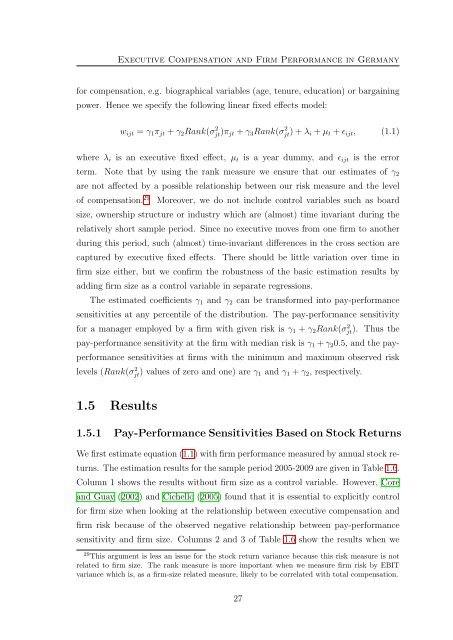Three Essays on Executive Compensation - KOPS - Universität ...
Three Essays on Executive Compensation - KOPS - Universität ...
Three Essays on Executive Compensation - KOPS - Universität ...
Create successful ePaper yourself
Turn your PDF publications into a flip-book with our unique Google optimized e-Paper software.
<strong>Executive</strong> Compensati<strong>on</strong> and Firm Performance in Germany<br />
for compensati<strong>on</strong>, e.g. biographical variables (age, tenure, educati<strong>on</strong>) or bargaining<br />
power. Hence we specify the following linear fixed effects model:<br />
w ijt = γ 1 π jt + γ 2 Rank(σ 2 jt)π jt + γ 3 Rank(σ 2 jt) + λ i + µ t + ɛ ijt , (1.1)<br />
where λ i is an executive fixed effect, µ t is a year dummy, and ɛ ijt is the error<br />
term. Note that by using the rank measure we ensure that our estimates of γ 2<br />
are not affected by a possible relati<strong>on</strong>ship between our risk measure and the level<br />
of compensati<strong>on</strong>. 29 Moreover, we do not include c<strong>on</strong>trol variables such as board<br />
size, ownership structure or industry which are (almost) time invariant during the<br />
relatively short sample period. Since no executive moves from <strong>on</strong>e firm to another<br />
during this period, such (almost) time-invariant differences in the cross secti<strong>on</strong> are<br />
captured by executive fixed effects. There should be little variati<strong>on</strong> over time in<br />
firm size either, but we c<strong>on</strong>firm the robustness of the basic estimati<strong>on</strong> results by<br />
adding firm size as a c<strong>on</strong>trol variable in separate regressi<strong>on</strong>s.<br />
The estimated coefficients γ 1 and γ 2 can be transformed into pay-performance<br />
sensitivities at any percentile of the distributi<strong>on</strong>. The pay-performance sensitivity<br />
for a manager employed by a firm with given risk is γ 1 + γ 2 Rank(σjt). 2 Thus the<br />
pay-performance sensitivity at the firm with median risk is γ 1 + γ 2 0.5, and the payperformance<br />
sensitivities at firms with the minimum and maximum observed risk<br />
levels (Rank(σjt) 2 values of zero and <strong>on</strong>e) are γ 1 and γ 1 + γ 2 , respectively.<br />
1.5 Results<br />
1.5.1 Pay-Performance Sensitivities Based <strong>on</strong> Stock Returns<br />
We first estimate equati<strong>on</strong> (1.1) with firm performance measured by annual stock returns.<br />
The estimati<strong>on</strong> results for the sample period 2005-2009 are given in Table 1.6.<br />
Column 1 shows the results without firm size as a c<strong>on</strong>trol variable. However, Core<br />
and Guay (2002) and Cichello (2005) found that it is essential to explicitly c<strong>on</strong>trol<br />
for firm size when looking at the relati<strong>on</strong>ship between executive compensati<strong>on</strong> and<br />
firm risk because of the observed negative relati<strong>on</strong>ship between pay-performance<br />
sensitivity and firm size. Columns 2 and 3 of Table 1.6 show the results when we<br />
29 This argument is less an issue for the stock return variance because this risk measure is not<br />
related to firm size. The rank measure is more important when we measure firm risk by EBIT<br />
variance which is, as a firm-size related measure, likely to be correlated with total compensati<strong>on</strong>.<br />
27
















